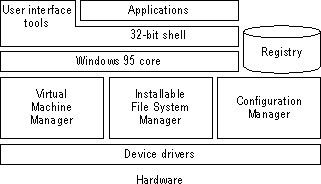 | ||
The architecture of Windows 9x series OS kernel is monolithic. The basic code is considered similar in function to MS-DOS - as a 16-/32-bit hybrid, it requires MS-DOS support to operate.
Contents
Critical files
The minimal Windows 95 so far was booted using the following set of files.
32-bit shell and command line interpreter
Windows 95 Core
Registry and other configuration files
Virtual Machine Manager and configuration manager
Installable file System Manager
Device drivers
The system may also use CONFIG.SYS (which contains settings and commands executed before loading the command interpreter) and AUTOEXEC.BAT (which is a batch file automatically executed after loading COMMAND.COM), but these two files aren't critical to the boot process, as Windows 9x IO.SYS contains a default setting for both, in case they're absent in the system. In Windows ME, CONFIG.SYS and AUTOEXEC.BAT are not processed. LOGO.SYS may be used as splash screen.
Boot sequence
The Windows 9x startup process consists of 6 phases. The first 2 of these steps are common to any operating system booting using the classic combination of BIOS and Master Boot Record - i.e. all IBM PC-compatible OSes of the era and the majority until the mid 2000s (compare UEFI and GUID Partition Table).
The ROM BIOS starts the execution at the physical memory address FFFF0h. During this phase, BIOS first executes Power-on self-test (POST), then checks the existence of boot disk on A drive. If it is not found in the A drive, the ROM BIOS checks for a hard disk. If the computer has a Plug and Play BIOS, in addition: BIOS checks RAM for I/O port addresses, interrupt lines, and DMA channels for Plug and Play devices, disables found devices, creates maps of used and unused resources and re-enables devices.
Master boot record is loaded at address 7C00h, and then it loads the boot sector of Windows Disk partition. The boot sector contains the disk boot program and BIOS Parameter Block (BPB) table which to finds the location of the root directory and IO.SYS file, and then loads IO.SYS file into memory.
IO.SYS initializes minimal FAT driver and reads MSDOS.SYS into memory. Then it displays "Starting Windows", depending on BootDelay=
Windows 95 and Windows 98 now analyze CONFIG.SYS and load MSDOS real mode drivers. Windows ME ignores this. If the CONFIG.SYS file does not exist, the IO.SYS file loads drivers: IFSHLP.SYS, HIMEM.SYS and SETVER.EXE. Windows reserves all upper memory blocks (UMB) for Windows 95 operating system use or for expanded memory EMS. Windows 95 and Windows 98 execute COMMAND.COM to process AUTOEXEC.BAT. It loads terminate and stay resident (TSR) programs into memory. Windows ME ignores this step.
IO.SYS now runs WIN.COM. WIN.COM loads the VMM32.VXD file into memory or it is accessed from the hard disk. This file contains most important drivers, but they can be replaced. The real-mode virtual device driver loader checks for duplicate virtual device drivers (VxDs) that exists both in the WindowsSystemVmm32 folder and the VMM32.VXD file. In a case of duplicates, the driver in the WindowsSystemVmm32 directory will be loaded. Windows 95 and 98 now query real mode drivers calling INT 2Fh, and looks for drivers in registry entry HKEY_LOCAL_MACHINESystemCurrentControlSetServicesVxD marked to be loaded as external file. Then vmm32 analyzes [386 Enh] section of the WindowsSystem.ini file, and loads drivers mentioned there. Some most important drivers are loaded even if they are not mentioned in Windows Registry, SYSTEM.INI or in WindowsSystemVmm32 directory.
Once the real-mode virtual device drivers are loaded, driver initialization, on Windows 95 and Windows 98 occurs. Vmm32 then switches CPU from real mode to protected mode. The next step is initialization of protected mode drivers. It is executed in three phases for each device: critical part of initialization (while interrupts are disabled), device initialization (when file I/O is allowed) and InitComplete phase. After initialization of display driver, Windows switch to graphical mode.
After all the drivers are loaded, the Kernel32.dll, gdi32.dll, Gdi.exe, user32.dll, User.exe, shell32.dll and Explorer.exe are loaded. The next step in the startup process is to load the network environment. The user is prompted to log on to the network that is installed. When a user logs on, his desktop settings are loaded from the registry, or the desktop configuration uses a default desktop. Windows then starts programs defined in the StartUp folder, WIN.INI, and programs defined in registry keys Run, RunOnce, RunServices and RunServicesOnce inside branches HKEY_LOCAL_MACHINESoftwareMicrosoftWindowsCurrentVersion and HKEY_CURRENT_USERSoftwareMicrosoftWindowsCurrentVersion. After each program in the RunOnce registry key is started, the program is removed from the key. Hourglass pointer is turned off.
Kernel
The Windows 9x kernel is a 32-bit kernel with virtual memory. Drivers are provided by .VXD files, or since Windows 98 the newer WDM drivers can be used. However the MS-DOS kernel stays resident in memory and Windows will use the old MS-DOS 16-bit drivers if they are installed.
